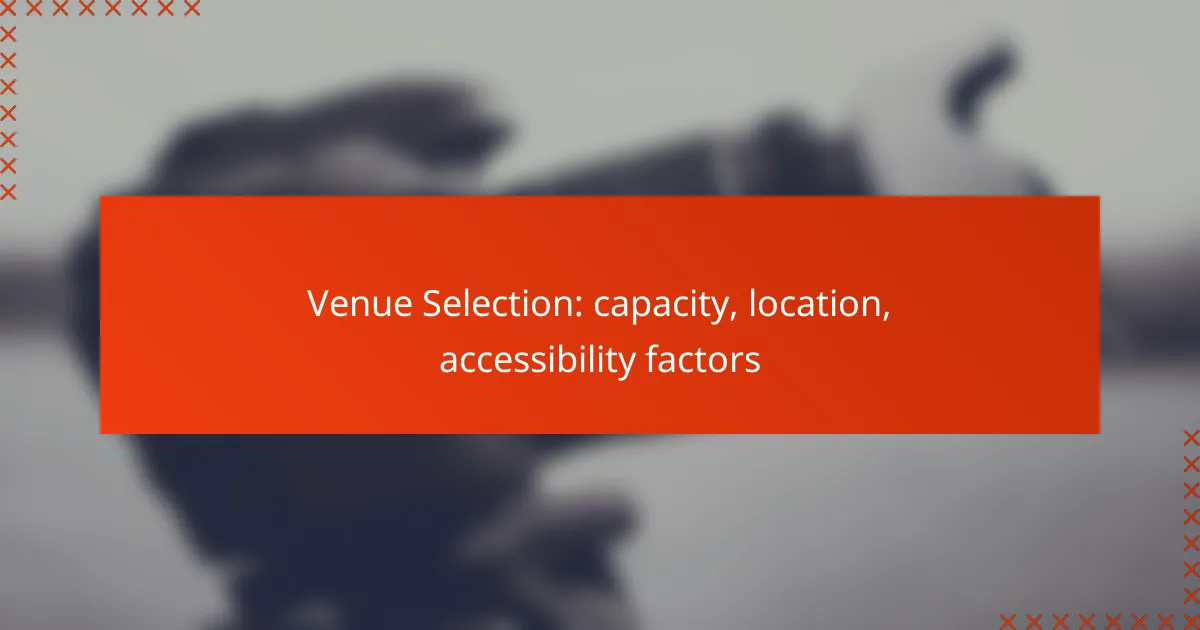Choosing the right venue is essential for the success of any event, with key factors such as capacity, location, and accessibility playing a pivotal role. Ensuring the venue can accommodate the expected number of attendees while being conveniently located near public transport and accommodations enhances the overall experience. Additionally, accessibility standards must be met to cater to all participants, making careful venue selection crucial for a seamless event.

What are the key factors for venue selection in Australia?
Key factors for venue selection in Australia include capacity requirements, location considerations, accessibility standards, cost implications, and available amenities. Each of these elements plays a crucial role in ensuring that the venue meets the needs of the event and its attendees.
Capacity requirements
Capacity requirements dictate the number of attendees a venue can accommodate comfortably. It’s essential to choose a venue that can handle your expected guest count without overcrowding or excessive empty space. For most events, aim for a venue that can hold at least 10-20% more than your anticipated attendance to account for last-minute changes.
Consider the layout as well; different setups (theater, banquet, classroom) can affect how many people fit in the same space. Always verify the venue’s maximum capacity with the management to avoid any surprises.
Location considerations
Location is critical for ensuring that attendees can easily reach the venue. Look for venues that are centrally located or near major transport links, such as airports or public transit stations. This can significantly impact attendance, especially for events attracting out-of-town guests.
Additionally, consider the surrounding area. Venues near hotels, restaurants, and attractions can enhance the overall experience for attendees, making it easier for them to network and socialize outside of the event.
Accessibility standards
Accessibility standards are vital to ensure all attendees can participate fully. In Australia, venues must comply with the Disability Discrimination Act, which mandates accessible facilities. This includes ramps, elevators, and accessible restrooms.
When selecting a venue, assess its accessibility features. Consider conducting a site visit to evaluate how well the venue accommodates individuals with disabilities, ensuring everyone can access all areas without difficulty.
Cost implications
Cost implications are a significant factor in venue selection, as they can vary widely based on location, capacity, and amenities. Establish a budget early on and consider not only the rental fee but also additional costs like catering, equipment, and service charges.
Compare multiple venues to find the best value for your needs. Look for packages that may include extras like audiovisual equipment or catering services, which can save you money and simplify planning.
Amenities and services
Amenities and services offered by a venue can greatly enhance the event experience. Consider what is included in the rental, such as audiovisual equipment, Wi-Fi, and furniture. Some venues may also provide on-site catering or event planning services, which can streamline logistics.
Evaluate the quality of these amenities as well. Read reviews or ask for recommendations to ensure that the services provided meet your expectations and contribute positively to the overall event experience.

How does venue capacity impact event planning?
Venue capacity significantly influences event planning by determining how many attendees can be accommodated comfortably and safely. Understanding capacity helps organizers select the right venue, ensuring a positive experience for participants while adhering to safety regulations.
Determining attendee numbers
Accurately estimating attendee numbers is crucial for selecting a venue that meets capacity requirements. Consider factors such as the type of event, target audience, and marketing strategies to gauge interest. A common approach is to plan for a range, typically estimating attendance at around 70-80% of total capacity to account for no-shows.
Using registration data or past event attendance can provide valuable insights. For larger events, consider implementing tiered ticket pricing to encourage early registration and better predict numbers.
Safety regulations
Safety regulations often dictate the maximum capacity of a venue based on fire codes and health guidelines. These regulations ensure that venues can safely accommodate attendees without overcrowding, which can lead to hazardous situations. Familiarize yourself with local regulations to avoid penalties and ensure compliance.
For example, in many regions, venues must provide a certain number of exits and maintain specific square footage per person. Always check with local authorities or venue management to confirm capacity limits and safety requirements.
Seating arrangements
Seating arrangements should align with venue capacity and the event’s format. For instance, theater-style seating maximizes capacity but may limit interaction, while banquet-style seating fosters engagement but requires more space. Choose an arrangement that suits the event’s purpose and audience dynamics.
Consider creating a seating plan that accommodates various needs, such as accessibility for individuals with disabilities. Additionally, ensure that there is enough space between seats for comfort and safety, adhering to any local regulations regarding spacing.

What location factors should be considered for venues in Australia?
When selecting a venue in Australia, key location factors include accessibility, proximity to public transport, and nearby accommodations. These elements significantly influence attendee convenience and overall event success.
Proximity to public transport
Choosing a venue close to public transport is essential for ensuring easy access for attendees. Venues located near train stations, bus stops, or tram lines can facilitate higher attendance rates, as guests can travel without needing a car.
Consider venues that are within a short walking distance—ideally under 500 meters—from major transport hubs. This proximity can enhance the overall experience and reduce logistical challenges.
Nearby accommodations
Having accommodations near the venue is crucial, especially for multi-day events or those attracting out-of-town guests. Look for venues that are surrounded by a range of hotels, motels, or serviced apartments to cater to different budgets.
A good rule of thumb is to have at least three to five accommodation options within a 10-minute walk from the venue. This arrangement makes it easier for attendees to find suitable lodging without extensive travel.
Local attractions
Local attractions can enhance the appeal of your venue by providing entertainment and activities for attendees before or after the event. Venues situated near popular sites such as parks, museums, or shopping areas can offer additional value to participants.
When assessing venues, consider their proximity to well-known attractions that can enrich the event experience. This can also help in promoting the venue to potential attendees, making it a more attractive option overall.

How does accessibility influence venue choice?
Accessibility significantly impacts venue selection by ensuring that all attendees can participate comfortably and safely. Factors such as compliance with regulations, facilities for disabled individuals, and parking options are critical in making an informed choice.
Compliance with Australian standards
Venues in Australia must adhere to the Disability Discrimination Act and relevant Australian Standards, such as AS 1428, which outlines requirements for access and mobility. This includes features like ramps, accessible restrooms, and clear signage. Ensuring compliance not only avoids legal issues but also promotes inclusivity.
When evaluating a venue, check for certification or documentation that confirms adherence to these standards. This can include inspection reports or compliance certificates, which provide assurance that the venue meets necessary accessibility requirements.
Facilities for disabled attendees
Facilities for disabled attendees should be a priority in venue selection. Look for features such as wheelchair-accessible entrances, elevators, and seating arrangements that accommodate various needs. Additionally, venues should offer assistive listening devices and tactile guides where applicable.
Consider the layout of the venue; it should allow for easy navigation without obstacles. A venue with designated areas for service animals and trained staff to assist can greatly enhance the experience for disabled attendees.
Parking availability
Parking availability is crucial for accessibility, particularly for those with mobility challenges. Ensure the venue has designated accessible parking spaces that are conveniently located near the entrance. These spaces should be clearly marked and comply with local regulations regarding size and placement.
It’s beneficial to assess the overall parking capacity and the ease of access to public transport options. Venues that provide shuttle services or are located near major transit hubs can offer additional convenience for all attendees, enhancing overall accessibility.

What are the best practices for evaluating venue options?
To effectively evaluate venue options, consider factors like capacity, location, and accessibility. A systematic approach ensures that the selected venue meets the needs of your event and attendees.
Site visits and inspections
Conducting site visits and inspections is crucial for assessing potential venues. This hands-on approach allows you to evaluate the space, layout, and overall ambiance, ensuring they align with your event’s requirements.
During the visit, pay attention to the venue’s capacity and how it accommodates your expected number of attendees. Check for essential facilities such as restrooms, parking, and emergency exits, which are vital for guest comfort and safety.
Take notes and photographs to compare venues later. Consider creating a checklist of must-have features and amenities to streamline your evaluation process.



